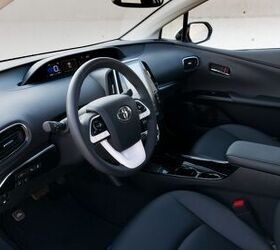The 2017 Toyota Prius Prime Advance emerges as a compelling option in the plug-in hybrid market, blending Toyota’s renowned hybrid technology with enhanced electric vehicle capabilities. This model, powered by a 1.8-liter inline-four engine paired with a plug-in hybrid electric motor, delivers a combined 121 horsepower, prioritizing fuel efficiency without completely sacrificing driving experience. Coupled with a continuously variable transmission and front-wheel drive, the Prius Prime is engineered for optimal fuel economy and urban maneuverability.
The EPA ratings for the 2017 Prius Prime are impressive, boasting 55 mpg in the city, 53 mpg on the highway, and 54 mpg combined. Furthermore, it achieves a remarkable 133 MPGe, highlighting its electric efficiency. In real-world testing, as experienced with this model, drivers can even surpass these figures, reaching upwards of 64.2 MPG, showcasing the vehicle’s potential for exceptional fuel savings. With a base price of $33,985 in the U.S., and an as-tested price of $35,112 including freight charges, the Prius Prime positions itself as a competitively priced, eco-conscious vehicle.
While the Prius lineup has sometimes faced criticism for prioritizing efficiency over driving dynamics, the 2017 Prius Prime offers a nuanced perspective. For those accustomed to performance vehicles, the focus on fuel economy might initially seem underwhelming. However, understanding the Prius Prime’s design intent is crucial. It’s engineered as an efficient and practical mode of transportation, particularly appealing to environmentally conscious consumers and those seeking to minimize fuel costs.
Despite initial biases against the Prius brand, a closer examination of the 2017 Prius Prime reveals its merits. The sharp, angular design, while perhaps not universally admired, departs from the purely utilitarian aesthetics sometimes associated with eco-focused vehicles.
Toyota has evolved the Prius’s distinctive hatchback silhouette over generations, and the 2017 Prime maintains this recognizable identity. Aerodynamic considerations are clearly paramount in its design, influencing the sloping roofline and sharply truncated rear. The unique contour of the rear window, while visually striking, presents a practical challenge in terms of rear visibility and wiper functionality, especially in inclement weather.
Stepping inside the 2017 Prius Prime, the interior design reflects Toyota’s commitment to functional modernity. The dashboard features a centrally mounted instrument cluster, a signature Prius element, complemented by a large 11.6-inch touchscreen. This screen serves as the command center for audio, climate control, and hybrid system information. While the reliance on touchscreen controls for frequently used functions like volume and temperature might not appeal to all drivers preferring tactile knobs, the screen’s clarity and responsiveness are commendable. Its size allows for a split-screen display, enabling simultaneous viewing of navigation maps and hybrid system performance data.
The seating surfaces, finished in Toyota’s “Softex” vinyl, offer a comfortable and arguably eco-conscious alternative to traditional leather. This material, reminiscent of Mercedes-Benz’s MB-Tex, balances comfort with durability and aligns with the environmental sensibilities of many hybrid vehicle buyers.
Driving the 2017 Prius Prime reveals the tangible benefits of its plug-in hybrid architecture. The larger battery pack compared to standard Prius hybrids significantly extends its electric driving range. This enhanced battery capacity allows for extended periods of all-electric driving, even at highway speeds. A full charge can provide approximately 27 miles of electric range, sufficient for many daily commutes. This capability allows drivers to minimize gasoline consumption during routine trips, contributing to substantial fuel savings and reduced emissions.
The placement of the charging port on the rear quarter panel might require some adjustment for users accustomed to front fender ports, particularly in driveway parking scenarios. However, this is a minor consideration in the overall ownership experience. The real-world fuel economy figures are where the Prius Prime truly shines. A week of mixed driving, including commuting and family errands, yielded an average of 64.2 mpg. This level of fuel efficiency is exceptional, particularly when compared to conventional gasoline vehicles.
In terms of driving dynamics, the 2017 Prius Prime exhibits typical hybrid braking characteristics. The transition between regenerative and friction braking can feel slightly abrupt initially but becomes less noticeable with familiarity. The low rolling resistance tires contribute to some road noise within the cabin, but this is largely offset by the quiet electric drivetrain. Even when the gasoline engine engages, the noise level remains well-contained. The Prius Prime offers a comfortable and relaxed driving experience, especially on longer highway journeys, aided by driver-assistance features like lane departure warning, steering assist, and radar cruise control, particularly in the Advanced trim.
While some Prius owners have historically resorted to “sport” mode to enhance throttle response in standard hybrid models, the 2017 Prius Prime’s increased electric power mitigates this need. The readily available electric torque provides ample responsiveness for most driving situations. The gasoline engine’s limitations become apparent primarily during demanding acceleration scenarios, such as passing maneuvers at highway speeds when the battery is depleted.
Ultimately, the 2017 Toyota Prius Prime Hybrid adeptly fulfills its intended purpose: providing highly efficient and practical transportation. It delivers the advantages of electric vehicle operation for daily commutes while retaining the flexibility of a gasoline engine for extended trips. For those prioritizing fuel economy and environmental responsibility without sacrificing practicality, the 2017 Prius Prime stands as a compelling and well-engineered choice in the plug-in hybrid segment.

